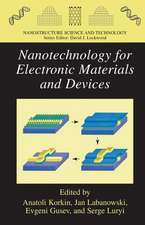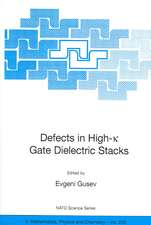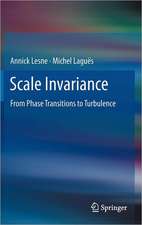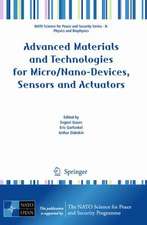Fundamental Aspects of Ultrathin Dielectrics on Si-based Devices: NATO Science Partnership Subseries: 3, cartea 47
Editat de Eric Garfunkel, Evgeni Gusev, Alexander Vul'en Limba Engleză Paperback – 31 mar 1998
Audience: Both expert scientists and engineers who wish to keep up with cutting edge research, and new students who wish to learn more about the exciting basic research issues relevant to next-generation device technology.
| Toate formatele și edițiile | Preț | Express |
|---|---|---|
| Paperback (1) | 955.08 lei 6-8 săpt. | |
| SPRINGER NETHERLANDS – 31 mar 1998 | 955.08 lei 6-8 săpt. | |
| Hardback (1) | 961.41 lei 6-8 săpt. | |
| SPRINGER NETHERLANDS – 31 mar 1998 | 961.41 lei 6-8 săpt. |
Din seria NATO Science Partnership Subseries: 3
- 24%
 Preț: 1567.19 lei
Preț: 1567.19 lei - 18%
 Preț: 1992.08 lei
Preț: 1992.08 lei -
 Preț: 393.13 lei
Preț: 393.13 lei -
 Preț: 390.63 lei
Preț: 390.63 lei - 18%
 Preț: 1849.41 lei
Preț: 1849.41 lei -
 Preț: 407.19 lei
Preț: 407.19 lei - 18%
 Preț: 1228.96 lei
Preț: 1228.96 lei - 18%
 Preț: 1843.73 lei
Preț: 1843.73 lei - 15%
 Preț: 642.51 lei
Preț: 642.51 lei -
 Preț: 402.76 lei
Preț: 402.76 lei - 18%
 Preț: 1829.86 lei
Preț: 1829.86 lei -
 Preț: 379.48 lei
Preț: 379.48 lei - 18%
 Preț: 1224.54 lei
Preț: 1224.54 lei -
 Preț: 401.42 lei
Preț: 401.42 lei - 18%
 Preț: 1841.68 lei
Preț: 1841.68 lei -
 Preț: 391.99 lei
Preț: 391.99 lei - 18%
 Preț: 1234.46 lei
Preț: 1234.46 lei -
 Preț: 405.28 lei
Preț: 405.28 lei -
 Preț: 396.62 lei
Preț: 396.62 lei - 18%
 Preț: 1226.73 lei
Preț: 1226.73 lei - 18%
 Preț: 1233.52 lei
Preț: 1233.52 lei - 18%
 Preț: 1228.62 lei
Preț: 1228.62 lei - 5%
 Preț: 377.52 lei
Preț: 377.52 lei - 18%
 Preț: 1830.49 lei
Preț: 1830.49 lei - 20%
 Preț: 336.21 lei
Preț: 336.21 lei - 18%
 Preț: 1225.48 lei
Preț: 1225.48 lei -
 Preț: 397.38 lei
Preț: 397.38 lei - 18%
 Preț: 1830.65 lei
Preț: 1830.65 lei - 15%
 Preț: 650.55 lei
Preț: 650.55 lei - 5%
 Preț: 1416.66 lei
Preț: 1416.66 lei
Preț: 955.08 lei
Preț vechi: 1164.73 lei
-18% Nou
Puncte Express: 1433
Preț estimativ în valută:
182.75€ • 191.32$ • 151.22£
182.75€ • 191.32$ • 151.22£
Carte tipărită la comandă
Livrare economică 05-19 aprilie
Preluare comenzi: 021 569.72.76
Specificații
ISBN-13: 9780792350088
ISBN-10: 0792350081
Pagini: 507
Ilustrații: XI, 507 p. 114 illus.
Dimensiuni: 160 x 240 x 27 mm
Greutate: 0.72 kg
Ediția:Softcover reprint of the original 1st ed. 1998
Editura: SPRINGER NETHERLANDS
Colecția Springer
Seria NATO Science Partnership Subseries: 3
Locul publicării:Dordrecht, Netherlands
ISBN-10: 0792350081
Pagini: 507
Ilustrații: XI, 507 p. 114 illus.
Dimensiuni: 160 x 240 x 27 mm
Greutate: 0.72 kg
Ediția:Softcover reprint of the original 1st ed. 1998
Editura: SPRINGER NETHERLANDS
Colecția Springer
Seria NATO Science Partnership Subseries: 3
Locul publicării:Dordrecht, Netherlands
Public țintă
ResearchCuprins
Ultrathin dielectrics in silicon microelectronics — an overview.- Section 1. Recent advances in experimental studies of SiO2films on Si.- Study of the Si/SiO2interface using positrons: present status and prospects.- Medium energy ion scattering studies of silicon oxidation and oxynitridation.- Synchrotron and conventional photoemission studies of oxides and N2Ooxynitrides.- Stress in the SiO2/Si structures formed by thermal oxidation.- Section 2. Theory of the SiO2/Si and SiOxNy/Si systems.- Modeling the oxide and the oxidation process: can silicon oxidation be solved?.- Core-level shifts in Si(001)-SiO2systems: the value of first-principle investigations.- A simple model of the chemical nature of bonds at the Si-SiO2interface and its influence on the electronic properties of MOS devices.- Chemical perspectives on growth and properties of ultrathin SiO2layers.- A theoretical model of the Si/SiO2interface.- Section 3: Growth mechanism processing and analysis of (oxy)nitridation.- Spatially-selective incorporation of bonded-nitrogen into ultra-thin gate dielectrics by low-temperature plasma-assisted processing.- Isotopic labeling studies of oxynitridation in nitric oxide (NO) of Si and SiO2.- Thermal routes to ultrathin oxynitrides.- Nitrogen in ultra thin dielectrics.- Endurance of EEPROM-cells using ultrathin NO and NH3nitrided tunnel oxides.- Effects of the surface deposition of nitrogen on the oxidation of silicon.- Section 4: Initial oxidation and surface science issues.- Surface interface and valence band of ultra-thin silicon oxides.- Low temperature ultrathin dielectrics on silicon and silicon carbide surfaces: from the atomic scale to interface formation.- Interaction of O2and N2O with Si during the early stages of oxide formation.- Scanning tunnelingmicroscopy on oxide and oxynitride formation, growth and etching of Si surfaces.- The interaction of oxygen with Si(100) in the vicinity of the oxide nucleation treshold.- Section 5: Electrical properties and microscopic models of defects.- Tunneling transport and reliability evaluation in extremely thin gate oxides.- Electrical defects at the SiO2/Si interface studied by EPR.- Towards atomic scale understanding of defects and traps in oxide/nitride/oxide and oxynitride systems.- A new model of photoelectric phenomena in MOS structures: outline and applications.- Point defect generation during Si oxidation and oxynitridation.- Optically induced switching in bistable structures: heavily doped n+- polysilicon - tunnel oxide layer - n - silicon.- Heterojunction AI/SiO2/n-Si device as an Auger transistor.- Radiation induced behavior in MOS devices.- Section 6: Hydrogen/Deuterium issues.- Hydrogenous species and charge defects in the Si-SiO2system.- The role of hydrogen in the formation reactivity and stability of silicon (oxy)nitride films.- Hydrogen-induced donor states in the MOS-system: hole traps, slow states and interface states.- Section 7: New substrates (SiC,SiGe) and SOI technologies Future trends in SiC-based microelectronic devices.- The initial phases of SiC-SiO2interface formation by low-temperature (300°C) remote plasma-assisted oxidation of Si and C faces on flat and vicinal 6H SiC.- Challenges in the oxidation of strained SiGe layers.- The current status and future trends of SIMOX/SOI, new technological applications of the SiC/SOI system.- Local tunnel emission assisted by inclusions contained in buried oxides.- Authors index.- List of workshop participants.










